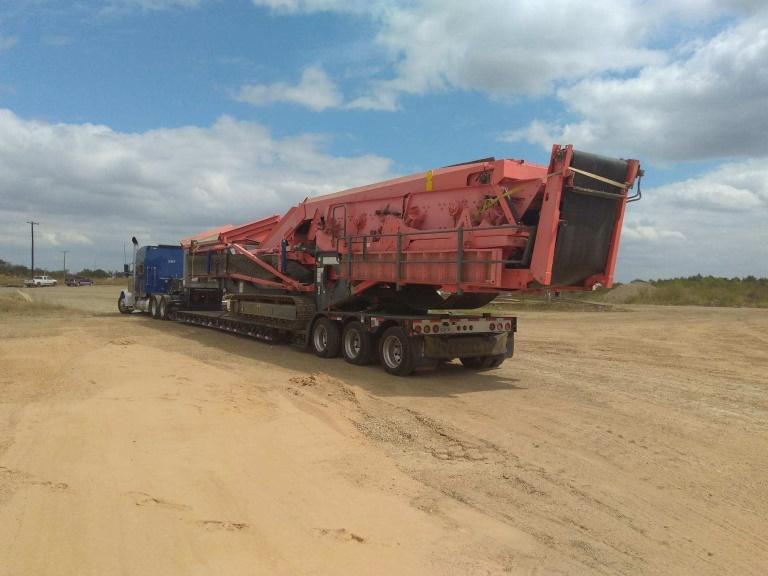How to Load a Cold Planer
How to Load a Cold Planer for Fast and Efficient Transportation
Preparing a cold planer transport for a long-distance haul is a process that requires proper planning. You need a trustworthy and reliable heavy-equipment shipper for a safe, secure, and timely delivery. Preparing a cold planer for a long haul is always easier said than done. The equipment features an awkward design consists of a conveyor and the body structure that houses the miller and the cabin. Loading it on a trailer can sometimes require shipping companies to put their creativity and ingenuity to work. This article offers insights into how you can load an asphalt milling equipment on a trailer for safe and secure transportation.

Loading a Cold Planer for Long-Distance Transport
Cold planers weigh up to 30 tons, making them heavy construction equipment transports. A semi-truck cannot capably handle such weight. It leaves the loading crew with a choice to look for an RGN or a low-bed trailer to make sure they meet the height and weight limitations on the road.
Expert truckers try as much as possible to position and cable the cold planning machinery within the confines of the trailer bed. Most companies load the piece of machinery with the conveyor facing forward and the control cabin toward the rear of the trailer. This position ensures even distribution of the equipment’s weight on the trailer.
Before the loading process begins, the RGN trailer pulls up on an even and sturdy loading ground. The removable gooseneck that attaches to the tractor is then removed to enable the deployment of the trailer ramps. The driver then starts the cold planer towards the trailer and aligns it to the ramp, with the hydraulic conveyor belt above the rear axles of the trailer. There should be a spotter, who guides the driver when positioning the equipment for loading. Once the machinery is well-positioned, the crew moves to ensure that the security of the cold planer on the trailer by assessing the offset of trailer sides from the crawlers. Next, the ramps are folded backwards, allowing them [loaders] to connect the RGN to the trailer for transportation.
When the cargo is loaded as such, the rear conveyor belt extends beyond the length of the trailer at an angle. That presents a challenge during the transport process, especially when negotiating corners with structures stemming on roadsides. The haulage requires pilot cars to scout the road, oversized-load flags, and escorts to ensure smooth and perfect cornering.
Why Choose Heavy Haulers to Haul a Cold Planer?
Industrialists using cold planers and other heavy equipment hire long-distance Heavy Haulers for various reasons. They include the following:
If people had the equipment and tools to transport oversize equipment, most of them would do that themselves. However, a reputable shipping firm is prepped with the necessary cargo-handling equipment such as trailers, cranes, and tractors. Since consumers cannot afford them, they are left to depend on professional shippers for the haul.
As a leading heavy-cargo shipping and transportation experts, we invest in expert logistics specialists who understand the transportation rules and regulations in each state. We also know how to plan out transportation routes, to retrieve permits, and maintaining legal loads for seamless transportation.
Every owner of a cold planer has unique needs from the other. Clients can rely on Heavy Haulers to provide customized hauling services that will guarantee them peace of mind. While one consumer will require police escort, another might need additional loading and offloading services. Heavy Haulers is a flexible and versatile transporting company that can expend tailored shipping packages.
Cold Planer Hauling: Types of Machines Applied Industrially
A cold planer is used for the removal of the asphalt layer of the road to make it level. The piece of massive machinery can also remove the entire thickness of the surface on bridges, roads, and other paved areas. Depending on the depth to which the grinder reaches on the surface, pavement milling equipment fall under five (5) classes. They include:
- Class I – Grinding to rid the surface of blemishes and other irregularities.
- Class II – Grinds uniformly to a specific depth according to the plans provided.
- Class II – Serves the same purpose as Class II machines but along a sloping ground.
- Class IV – The milling reaches full depth into the ground, reaching the subgrade level.
- Class V – Grinding to various depths. They work excellently in any location.
Transport Your Cold Planer With Heavy Haulers Today!
Step 1: Fill Out Quote Form
Fill out the short & easy quote form.
Step 2: Speak With An Agent
We’ll pick up your heavy equipment or vehicle.
Step 3: Get Transported On Time
We deliver on time so you can get back to work.